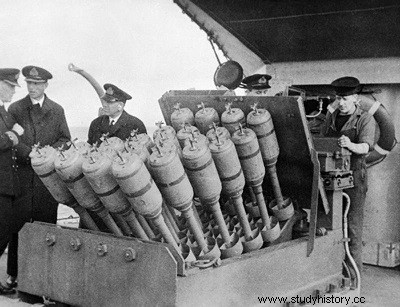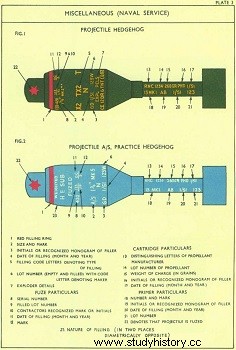The "Hedgehog"

Ideal complement to ASDIC, it was a multiple launcher with spurs; it projected at the front of the building, with a certain dispersion, 24 contact rocket bombs each containing 15 kg of Torpex, a powerful explosive. This allowed firing before the ASDIC contact of the submarine was lost. In addition, the dispersion of impacts inside an ellipse gave a high chance of a hit. The firing being done by contact fuze, an explosion gave the quasi certainty that the U-boat was hit.
The Royal Navy had already considered all these problems before the war and its submarine weapons service had tried to solve them; in fact he had found a solution, but could not make it operational. It consisted in throwing the grenade at the front of the building while it still had the ASDIC contact of the U-boat. A few projects had been worked out; but there was an insurmountable technical difficulty:making a cannon that could launch such a heavy charge at the desired distance, without the recoil of the shot damaging the launching building.
That's when that the MD1 service entered the scene with the study of the ergot mortar. The principle was that at the start of the projectile, the lug recoiled, which rearmed it for the next shot. In addition, the firing was carried out under the action of a spring which threw the lug forwards, causing the cartridge to strike. Thus the explosion, on the one hand, launched the projectile, on the other hand, slowed down the ergot and sent it back. All this helped to absorb recoil, made it possible to launch, in some cases, a heavy projectile with a handy weapon, which could be carried on the shoulder.
A group of researchers from the English Admiralty heard about this work on the lug mortar, and understood that there was a way to project a heavy anti-submarine charge, with a recoil low enough for the bridge of the building can support it. The Admiralty commissioned the MDI to develop it, and. soon after, an electrically ignited mortar was introduced.
Pre-war studies had also shown that throwing several grenades together would give every chance of destroying a submarine. marine. But the simultaneous firing tests revealed that the forces undergone by the building's deck were too great; also the firing circuit was provided with a timing device for the throwing of grenades two by two at short intervals.
It remained to determine the best distribution of the points of impact; tests were carried out on dry land. the outline of a normal sized U-boat being drawn on the ground; it was thus possible to arrange the launching lugs in such a way that the impacts were inscribed inside a circle with a diameter less than the length of the submarine. The width of it being greater than the areas affected by each grenade. the U-boat could therefore not escape destruction provided that the grouped fire was well adjusted.
This last condition was essential, because the explosion was no longer caused by a firing device at a determined depth, which required, to be effective, a very large explosive charge. The ergot mortar launched much smaller grenades. containing 15 kg of explosive instead of 150; with this relatively low charge, the grenade had to explode on contact with the submarine to damage it; also it was equipped with a fuse functioning in the shock against the objective.

The machine was finally ready, and it had to be given a name . After various suggestions, it was named "Hedgehog" because, when uncharged, the spurs looked like erect quills. Now all that remained was to “sell” it to the Royal Navy and have it officially accepted, a much more difficult thing than one might imagine. At that time the threat of U-boats had worked the imagination of many inventors, and there were several projects of underwater weapons, differing little between them, at least on paper. In reality none was worth the “Hedgehog”. It was even noticed that in one of the projects, the grenades were launched at such low speed that the launching building caught up with them, thus becoming the target of its own machines; this was noticed at the start of the tests and this form of "maritime suicide" was not carried out.
A brand spectator
Chance would have it that Winston Churchill, during a visit to the MDI test base
agreed to see "in passing" the Hedgehog at work. The machine worked admirably (experience shows that weapons often have quirks when they are asked to prove their talent in front of distinguished visitors); Churchill was satisfied and the Hérisson immediately entered service.
This machine had a slight drawback:its electric firing system. It was thought in the offices that it risked breaking down in contact with the spray, in rough seas - such as the North Atlantic - and it was decided to study a new version equipped with a percussion firing. This one was called "porcupine", but it did not respond to what was expected. A prototype was manufactured, the functioning of which, during the tests, proved to be irregular and unsatisfactory; this project was therefore abandoned.
Although the Hedgehog was satisfactory, it was thought that a stronger explosion might be effective in case the grenade missed; a device called “Amok” was then made, which consisted of a model II grenade containing 80 kg of explosive and surrounded by 12 51 mm rocket motors. Launched from a simple steel angle support, Amok had a range of 450 m. If you wanted to shoot less far, you just had to withdraw rockets, two by two, in order to reduce the thrust; it was simple but effective. Although initially intended to be launched on the front, it was soon realized that the machine could be launched in any direction with a launcher on an orientable mounting; this allowed the submarine hunter to hold the entire surface of the surrounding water under fire.
